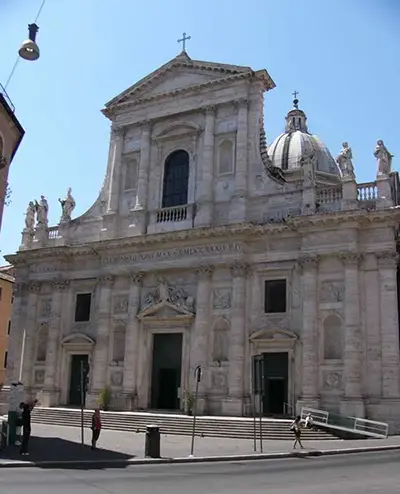San Giovanni dei Fiorentini’s inception can be traced back to the mid-fifteenth century, and to the founding of a company established by some of the many Florentine bankers and artists who had made Rome their home.
At the time, epidemics of plague and sweating sickness were sweeping the city. Wanting to find ways to help their fellow Florentine expatriates, the company met regularly at various churches in the centre of Rome. Given the opportunity to raise their own church on a newly built street, the Via Guilia, they decided to take it.
A competition for someone to design the building attracted considerable attention. Architecture was not a distinct profession, and many people combined its practice with work as an artist. Sansovino, one such man, was awarded the commission but his plans foundered, quite literally, on the riverside, where the new church was to be built. By 1521, he had given up.
It was another two years before work restarted, this time at the prompting of Pope Clement VII. Himself a native of Florence, he appointed Antonio da Sangallo the Younger to have charge of the project. It was a wise appointment.
With experience in working as both an architect and a military engineer, Sangallo was able to have the foundations laid without further trouble.
Mutiny and Schism
Unfortunately, progress stopped again when troops belonging to Charles V, the Holy Roman Emperor, mutinied in 1527. Although Pope Clement VII initially escaped, he was forced to surrender, and eventually to cede the bishopric of Utrecht to the Habsburgs.
More significantly, the embarrassment of the affair was one of the reasons why Clement VII steadfastly refused to sanction the divorce of England’s Henry VIII from Charles V’s aunt, Catherine of Aragon. This led directly to England's schism with the Roman Catholic church.
The part-built church at the end of the Via Giulia might seem a small matter when set against all the political and religious machinations involving the Holy Roman Emperor, the Pope and a King of England, but its importance was undiminished in the eyes of Rome's company of Florentine artists and bankers.
In 1534, work restarted under Sangallo, and went on until his death twelve years later. Even so, not a stone or a brick of the church itself had yet been laid.
Michelangelo and No Money
In 1559, during the hiatus following Sangallo’s death, the artist and architect, Michelangelo Buonarroti, produced five designs for the building. Helped by his sculptor student, Tiberio Calcagni, he based each on the classical Greek cross plan.
However, lack of financing stymied progress, and none of the designs were ever realised.
At Last: a Church is Built
It was not until 1584 that work restarted under Giacomo della Porta, an experienced architect and sculptor who had also worked on St Peter’s Basilica. Carlo Maderno replaced him in 1602, but, as with some of his predecessors, struggled with reconciling expectations for the building's appearance with the money available to fund it.
However, by 1620, the building, built following the design of a Latin cross, was more or less complete. Work continued on its sanctuary for many years under a number of different architects and mostly sponsored by a local family, who gave large sums in return for having their own memorial plaques on the interior walls of the church.
Finally, in 1738, almost three hundred years since the church had first been proposed, the entrance façade, in elegant white limestone, was completed. The result is one of the largest, and showiest, expatriate churches in Rome.


